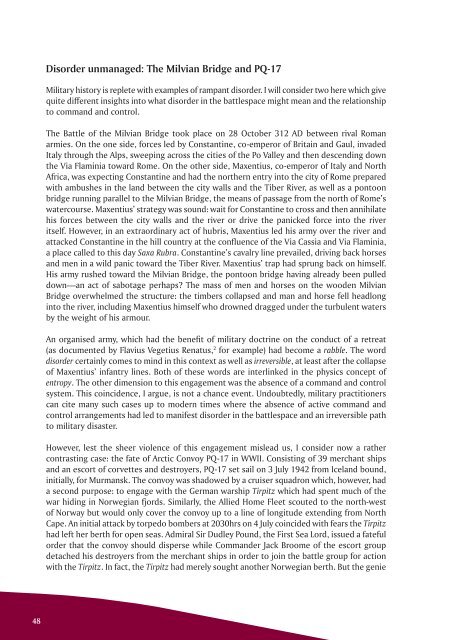ISSUE 176 : Jul/Aug - 2008 - Australian Defence Force Journal
ISSUE 176 : Jul/Aug - 2008 - Australian Defence Force Journal
ISSUE 176 : Jul/Aug - 2008 - Australian Defence Force Journal
You also want an ePaper? Increase the reach of your titles
YUMPU automatically turns print PDFs into web optimized ePapers that Google loves.
Disorder unmanaged: The Milvian Bridge and PQ-17<br />
Military history is replete with examples of rampant disorder. I will consider two here which give<br />
quite different insights into what disorder in the battlespace might mean and the relationship<br />
to command and control.<br />
The Battle of the Milvian Bridge took place on 28 October 312 AD between rival Roman<br />
armies. On the one side, forces led by Constantine, co-emperor of Britain and Gaul, invaded<br />
Italy through the Alps, sweeping across the cities of the Po Valley and then descending down<br />
the Via Flaminia toward Rome. On the other side, Maxentius, co-emperor of Italy and North<br />
Africa, was expecting Constantine and had the northern entry into the city of Rome prepared<br />
with ambushes in the land between the city walls and the Tiber River, as well as a pontoon<br />
bridge running parallel to the Milvian Bridge, the means of passage from the north of Rome’s<br />
watercourse. Maxentius’ strategy was sound: wait for Constantine to cross and then annihilate<br />
his forces between the city walls and the river or drive the panicked force into the river<br />
itself. However, in an extraordinary act of hubris, Maxentius led his army over the river and<br />
attacked Constantine in the hill country at the confluence of the Via Cassia and Via Flaminia,<br />
a place called to this day Saxa Rubra. Constantine’s cavalry line prevailed, driving back horses<br />
and men in a wild panic toward the Tiber River. Maxentius’ trap had sprung back on himself.<br />
His army rushed toward the Milvian Bridge, the pontoon bridge having already been pulled<br />
down—an act of sabotage perhaps? The mass of men and horses on the wooden Milvian<br />
Bridge overwhelmed the structure: the timbers collapsed and man and horse fell headlong<br />
into the river, including Maxentius himself who drowned dragged under the turbulent waters<br />
by the weight of his armour.<br />
An organised army, which had the benefit of military doctrine on the conduct of a retreat<br />
(as documented by Flavius Vegetius Renatus, 2 for example) had become a rabble. The word<br />
disorder certainly comes to mind in this context as well as irreversible, at least after the collapse<br />
of Maxentius’ infantry lines. Both of these words are interlinked in the physics concept of<br />
entropy. The other dimension to this engagement was the absence of a command and control<br />
system. This coincidence, I argue, is not a chance event. Undoubtedly, military practitioners<br />
can cite many such cases up to modern times where the absence of active command and<br />
control arrangements had led to manifest disorder in the battlespace and an irreversible path<br />
to military disaster.<br />
However, lest the sheer violence of this engagement mislead us, I consider now a rather<br />
contrasting case: the fate of Arctic Convoy PQ-17 in WWII. Consisting of 39 merchant ships<br />
and an escort of corvettes and destroyers, PQ-17 set sail on 3 <strong>Jul</strong>y 1942 from Iceland bound,<br />
initially, for Murmansk. The convoy was shadowed by a cruiser squadron which, however, had<br />
a second purpose: to engage with the German warship Tirpitz which had spent much of the<br />
war hiding in Norwegian fjords. Similarly, the Allied Home Fleet scouted to the north-west<br />
of Norway but would only cover the convoy up to a line of longitude extending from North<br />
Cape. An initial attack by torpedo bombers at 2030hrs on 4 <strong>Jul</strong>y coincided with fears the Tirpitz<br />
had left her berth for open seas. Admiral Sir Dudley Pound, the First Sea Lord, issued a fateful<br />
order that the convoy should disperse while Commander Jack Broome of the escort group<br />
detached his destroyers from the merchant ships in order to join the battle group for action<br />
with the Tirpitz. In fact, the Tirpitz had merely sought another Norwegian berth. But the genie<br />
48

















